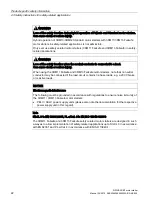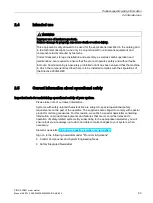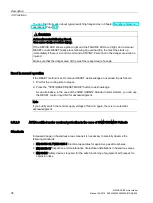
Description
3.5 Functions
SIRIUS 3RM1 motor starter
36
Manual, 06/2016, A5E0345285095020A/RS-AE/005
The fault state is indicated by LEDs and the fault signaling output.
NOTICE
Damage due to asymmetrical current consumption by built-in brakes
When connecting and operating motors with built-in brakes, the energy for releasing the
brakes is taken from the motor connection cables. This can result in substantial asymmetry
in power consumption.
The following applies to 3RM1 Standard and Failsafe motor starters:
•
If the current for the braking device is taken from two phases, connect the motor cables
that are additionally loaded with braking current to terminals T1 and T3. Observe the
additional braking current when setting the motor current.
•
Alternatively, the braking device can be fed externally.
An additional braking device can only be installed for Standard 3RM1 motor starters:
•
If the current for the braking device is taken from just one phase and the neutral
conductor, connect the motor cable that is loaded with the braking current to terminal T2
of the motor starter.
Do not use 3RM11 Failsafe and 3RM13 Failsafe motor starters for braking devices of
this kind.
NOTICE
Damage from incorrect connection
Incorrect connection of the motor can result in damage.
Connect the motor as specified in the typical circuit diagrams.
You can find circuit diagrams for operating motors with brakes in the chapter "Typical circuits
(Page 167)".
3.5.2.4
Asymmetry monitoring
Asymmetry detection will only work if all three phases are directly dependent upon one
another, i.e. when no external current flow is possible.
Asymmetry is detected as soon as one of the three phases deviates by more than 40 % from
the mean value of all phases. As soon as this happens, the 2-pole trip curve CLASS 10 A is
applied (see Chapter "Overload protection/device protection characteristic (Page 145)"). This
means: The function trips as soon as a minimum value of 85.5 % of the set rated current is
reached. If the current is below 85.5 % of the set rated current in all three phases, the
function will not trip. For values above 85.5 % of the set current, the higher the current, the
faster the function will trip.






























